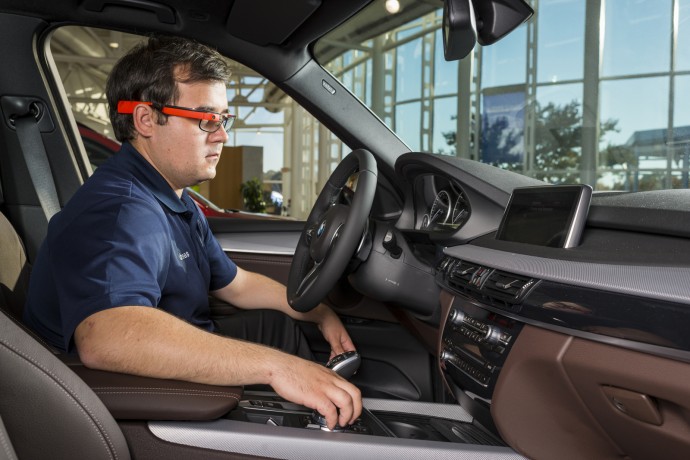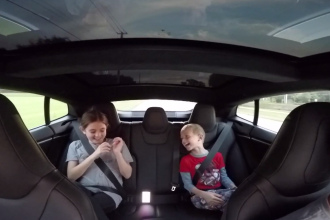It’s an innovative way to move a car model from the pre-series testing phase and into production; and it’s one that will likely make BMW mechanics and testers look like they’re tethered into JARVIS (Pardon the Iron Man reference).
The luxury auto-manufacturer’s November press release essentially stated that they’re now going to integrate Google Glass into their BMW 4.0 campaign, which is being implemented for the purpose of leveraging advanced technologies during production and planning phases.
Hands-Off and Heads-Up
The concept behind Google Glass isn’t a new one, but it was the tech-titan that brought the idea into the public eye. However, while Glass appears to have been met with excitement from within the tech community, the rest of society approaches with hesitation. Individuals wearing Glass are usually frowned upon in public, and have even been banned in certain public areas (such as movie theaters), but for testers, developers, and mechanics on the job? Glass appears to be offering some interesting hi-tech solutions to a few rather annoying, time-consuming problems in testing pre-series BMW cars:
- It keeps tester’s hands off other devices and on the wheel
- Glass’s data input will provide a media feed for designers to see instantly and record
- Those working with the car will be able to evaluate, analyze, and compare information from other models in the series right from the driver’s seat.
Perhaps the biggest reason why BMW is adopting the Glass method in planning and producing their pre-series cars is because the testing phase is the most arduous. Data must be exchanged between the testers in Spartanburg, SC, and wherever the BMW design team is located – and because that data can sometimes be too vague or difficult to interpret, BMW says that this will help “…improve and accelerate the workflows in quality assurance.”
Why This Could Work Wonders. For BMW, At Least.
Integrating Google Glass into BMW’s pre-series car model development has the potential to revolutionize the way cars are designed, given the sheer amount of data that the wearable device is capable of extracting.
In addition, it gives testers and mechanics a hands-free way of receiving, evaluating, recording, and sending this data without ever having to stop the car. If there was ever a way to streamline pre-series testing and design, this would be it. Glass is going to make a major impact in a favorable way.
However, it might not yet prove that automobiles and tech devices are a good pair in general. Everyday drivers aren’t testers, and testers likely aren’t evaluating a pre-series car while commuting to work.
It’s an ‘apples vs. oranges’ kind of issue. Good for testing cars, but probably not for surfing Netflix en route to pick up the kids from school. Honestly, there are already enough distractions and etiquette faux pas in the course of our day without strapping a computer to our heads. This isn’t to say that wearable devices won’t benefit and assist humans, but as of yet, mobile devices (even the wearable ones) and automobiles haven’t been mixing well.
At least, that researchers know of.
Is That a Blind Spot On Your Face?
An article from the New York Times posted data from a recent study explaining how Google Glass can put a blind spot between the user and whatever the user needs to see: “The device created a clinically meaningful visual field obstruction in the upper right quadrant.”
It’s already fairly obvious that driving an automobile whilst distracted is a human killer. The US government even saw fit to give the issue its own slightly macabre website. An appropriate gesture, given the fact that 3,320 people were victims of distracted driving in 2012.
But many have made the case that the driver simply needs to remain hands-free of distracting devices, and thus would contribute to a safe driving environment. However, according to a study that was discussed in a Wired.com article, it seems as though “…using any kind of technology negatively impacts your attention to driving.” This includes the use of Glass.
Whether using voice commands or touching a screen, using devices still adds workload for a brain that is already trying to concentrate on the road navigation. The main difference is that one is simply more problematic than the other – but both are still considered dangerous.
Safer Than a Smartphone
The purpose of the BMW’s use of Google Glass is not to make a social statement, or really even for the purpose of keeping their testers safe on the track. They seem to be implementing Glass in their BMW 4.0 campaign in order to increase the efficiency of designing cars. In which case, Glass gets the job done.
On the other hand, Glass is still an imperfect solution, and the concept still needs to work out quite a few bugs before these device can offer assistance to drivers and increase our safety on the roads. But that time is likely to come soon – especially since drivers are not easily parted with their devices, and technology is always advancing.
Photo Credit: BMW


